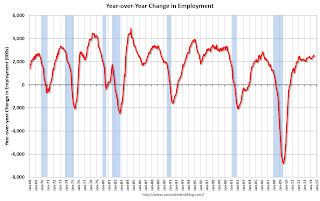by Calculated Risk on 9/27/2014 01:11:00 PM
Saturday, September 27, 2014
Schedule for Week of September 28th
This will be a busy week for economic data. The key report is the September employment report on Friday.
Other key reports include the August Personal Income and Outlays report on Monday, the July Case-Shiller House Price Index on Tuesday, the ISM manufacturing index and September vehicle sales both on Wednesday, and the August Trade Deficit and September ISM non-manufacturing index on Friday.
Also, Reis is scheduled to release their Q3 surveys of rents and vacancy rates for apartments, offices and malls.
8:30 AM: Personal Income and Outlays for August. The consensus is for a 0.3% increase in personal income, and for a 0.4% increase in personal spending. And for the Core PCE price index to be unchanged.
10:00 AM ET: Pending Home Sales Index for August. The consensus is for a 0.3% decrease in the index.
10:30 AM: Dallas Fed Manufacturing Survey for September.
 9:00 AM: S&P/Case-Shiller House Price Index for July. Although this is the June report, it is really a 3 month average of May, June and July.
9:00 AM: S&P/Case-Shiller House Price Index for July. Although this is the June report, it is really a 3 month average of May, June and July.NOTE: S&P is now releasing the National house price index monthly, and I expect reporting to shift from the Composite 20 to the National index. The National index was up 6.2% year-over-year in June.
This graph shows the nominal seasonally adjusted Composite 10 and Composite 20 indexes through the June 2014 report (the Composite 20 was started in January 2000).
The consensus is for a 7.5% year-over-year increase in the Composite 20 index (NSA) for July. The Zillow forecast is for the Composite 20 to increase 7.0% year-over-year, and for prices to increase 0.1% month-to-month seasonally adjusted.
9:45 AM: Chicago Purchasing Managers Index for September. The consensus is for a reading of 61.5, down from 64.3 in August.
7:00 AM: The Mortgage Bankers Association (MBA) will release the results for the mortgage purchase applications index.
 All day: Light vehicle sales for September. The consensus is for light vehicle sales to decrease to 16.8 million SAAR in September from 17.4 million in August (Seasonally Adjusted Annual Rate).
All day: Light vehicle sales for September. The consensus is for light vehicle sales to decrease to 16.8 million SAAR in September from 17.4 million in August (Seasonally Adjusted Annual Rate).This graph shows light vehicle sales since the BEA started keeping data in 1967. The dashed line is the August sales rate.
8:15 AM: The ADP Employment Report for September. This report is for private payrolls only (no government). The consensus is for 200,000 payroll jobs added in September, down from 205,000 in August.
Early: Reis Q3 2014 Office Survey of rents and vacancy rates.
 10:00 AM: ISM Manufacturing Index for September. The consensus is for a decrease to 58.0 from 59.0 in August
10:00 AM: ISM Manufacturing Index for September. The consensus is for a decrease to 58.0 from 59.0 in AugustHere is a long term graph of the ISM manufacturing index.
The ISM manufacturing index indicated expansion in August at 59.0%. The employment index was at 58.1%, and the new orders index was at 66.7%.
10:00 AM: Construction Spending for August. The consensus is for a 0.5% increase in construction spending.
Early: Reis Q3 2014 Apartment Survey of rents and vacancy rates.
8:30 AM: The initial weekly unemployment claims report will be released. The consensus is for claims to increase to 297 thousand from 293 thousand.
10:00 AM: Manufacturers' Shipments, Inventories and Orders (Factory Orders) for August. The consensus is for a 9.4 decrease in August orders.
8:30 AM: Employment Report for September. The consensus is for an increase of 215,000 non-farm payroll jobs added in September, up from the 142,000 non-farm payroll jobs added in August.
The consensus is for the unemployment rate to be unchanged at 6.1% in September.
 This graph shows the year-over-year change in total non-farm employment since 1968.
This graph shows the year-over-year change in total non-farm employment since 1968.In August, the year-over-year change was 2.482 million job, and it generally appears the pace of hiring is increasing.
Right now it looks possible that 2014 will be the best year since 1999 for both total nonfarm and private sector employment growth.
As always, a key will be the change in real wages - and as the unemployment rate falls, wage growth should eventually start to pickup.
Early: Reis Q3 2014 Mall Survey of rents and vacancy rates.
 8:30 AM: Trade Balance report for August from the Census Bureau.
8:30 AM: Trade Balance report for August from the Census Bureau. Imports and exports increased in July.
The consensus is for the U.S. trade deficit to be at $40.7 billion in August from $40.5 billion in July.
10:00 AM: ISM non-Manufacturing Index for September. The consensus is for a reading of 58.8, down from 59.6 in August. Note: Above 50 indicates expansion.
Unofficial Problem Bank list declines to 432 Institutions
by Calculated Risk on 9/27/2014 08:12:00 AM
This is an unofficial list of Problem Banks compiled only from public sources.
Here is the unofficial problem bank list for Sept 26, 2014.
Changes and comments from surferdude808:
The FDIC provided us with an update on its enforcement action activities through August. The update led to five removals and two additions that leave the Unofficial Problem Bank List at 432 institutions with assets of $136.8 billion. A year ago, the list held 690 institutions with assets of $240.5 billion. For the month, the list declined by seven institutions after eight action terminations, two mergers, and three additions. Over the past 28 months, the list has been declining but the drop this month is the smallest over this period.CR Note: The first unofficial problem bank list was published in August 2009 with 389 institutions. The list peaked at 1,002 institutions on June 10, 2011, and is now down to 432.
The FDIC terminated actions against The Bank of Elk River, Elk River, MN ($350 million); Flathead Bank of Bigfork, Montana, Bigfork, MT ($209 million); First State Bank, Wrens, GA ($90 million); Waterman State Bank, Waterman, IL ($42 million); and Marshall County State Bank, Varna, IL ($28 million).
The FDIC issued actions against Independence Bank, East Greenwich, RI ($53 million) and Alamerica Bank, Birmingham, AL ($39 million).
Next week should be light in terms of changes to the list but we will bring an update to the problem bank transition matrix.
Friday, September 26, 2014
Trivial: Bill Gross and Yoga in 2007
by Calculated Risk on 9/26/2014 04:44:00 PM
Several years ago, I occasionally attended the same yoga class as former PIMCO CIO Bill Gross.
In June 2007 (a few months before the recession started), I was waiting for a yoga class and happened to be standing right next to Mr. Gross.
Some random guy walked up to Gross and asked him if it was time to buy distressed bonds (Tanta and I were writing about the coming recession and how many financial institutions would be in trouble or gone).
Gross answered "probably" (time to buy distressed bonds) ... and I almost screamed "No". Then I realized maybe Gross didn't like that guy ... or he didn't like being asked about bonds at a yoga class.
Of course neither of them knew me - but I called Tanta after the class and told her what Gross said. And that was the source of Tanta's joke in this post: BONG HiTS 4 BILL GROSS!
Merrill and Nomura Forecasts for September Non-Farm Payrolls
by Calculated Risk on 9/26/2014 12:05:00 PM
The September employment report will be released next Friday, October 3rd, and the consensus is that 200 thousand payroll jobs were added in September and the unemployment rate was unchanged at 6.1%.
Here are two forecasts:
From Merrill Lynch:
The September employment report is likely to reveal solid job growth of 235,000 with possible upward revisions to prior months. Job growth was disappointing in August, only increasing 142,000, notably below the recent trend. There has been a pattern of upward revisions to the jobs report in August, averaging about 30,000. Our forecast for September combined with likely positive revisions should keep the 3-month moving average for payrolls above 200,000. Among the components, we think government jobs will be up 10,000 while private payrolls expand 225,000. We forecast a strong gain in manufacturing jobs, reflecting healthy improvement in the survey data. Job growth in the retail sector should also be solid after a decline in August. The continued modest improvement in housing construction should continue to support hiring in the sector.From Nomura:
We forecast the unemployment rate to hold steady at 6.1% in September. The labor force participation rate fell in August while household jobs were particularly soft. We do not expect the same for September, although there is a great deal of uncertainty in the monthly forecasts of labor force participation. Average hourly earnings are likely to continue to increase at a trend 0.2% mom rate, which will push the yoy rate up to 2.2%. While this is a pickup from the annual pace in August, it is within the recent range for growth in average hourly earnings.
emphasis added
Payroll growth surprised to the downside in August. However, incoming labor market indicators released since the last jobs report have been generally more favorable for payroll growth. Initial jobless and continuing claims are still near pre-recession levels. In addition, regional manufacturing surveys released thus far in September suggest that manufacturing employment continued to increase.CR Note: In August, a strike at Market Basket in New England negatively impacted the employment report. From BLS Commissioner Erica Groshen:
Based on these labor market readings in September, we forecast a 200k increase in private payrolls, with a 10k increase in government jobs, implying that total nonfarm payrolls will gain 210k. Furthermore, given the solid momentum implied by regional manufacturing surveys, we expect manufacturing employment to grow by 15k. We forecast that average hourly earnings for private employees rose by 0.25% again in September, supporting our forecast of a gradual pick-up in wage inflation. Lastly, based on the improvement in continuing jobless claims, we expect the household survey to show that the unemployment rate fell 0.1pp to 6.0%.
Within retail, employment declined in food and beverage stores (-17,000); this industry was impacted by employment disruptions at a grocery store chain in New England.The disruption ended quickly, and food and beverage employment should bounce back in September.
Final September Consumer Sentiment at 84.6
by Calculated Risk on 9/26/2014 09:55:00 AM
Click on graph for larger image.
The final Reuters / University of Michigan consumer sentiment index for September was at 84.6, unchanged from the preliminary reading of 84.6, and up from 82.5 in August.
This was at the consensus forecast of 84.6. Sentiment has generally been improving following the recession - with plenty of ups and downs - and a big spike down when Congress threatened to "not pay the bills" in 2011.



